ESL/EFL Fun Games - For Teachers & Students
Sorry folks, the forum got taken down because it became a paradise for spammers. Guess what! We partnered with www.eslgamesworld.com to bring you an ESL Games Page - Find Tons of Interactive, PPT & Printable Games by Clicking Here or Visiting the Links Below.
English Teachers
We offer printable grammar and vocabulary exercises to make the lives of English teachers very easy.English Students
This site has a large collection of free self-study grammar and vocabulary exercises for students.Printable Games, PPT Games & Game Templates
Board Games
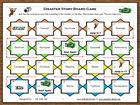
ESL Crocodile Board Game - Editable Template Download here!
The Crocodile Board game is ideal for activities that you do not want to take too long. It is quite a flexible game whose rules can be changed to extend the game or add more language. In this game, you need dice and chips. Players roll the dice and advance according to the number that shows up. If they land on the crocodile, they go back to start. If they land on the monkey they jump to an indicated number. They use words in the game to make sentences, ask questions or do whatever language skill the teacher wants them to practice. See the samples below and download the template to create customized games for your students.
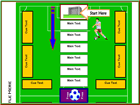
ESL Football Board Game- Editable Template Download here!
This football game is ideal for activities that require students to collocate words and make sentences. It is therefore a great vocabulary and grammar practice game. Give your ESL/EFL students communicative practice while having fun. In this game there are CUE WORDS and MAIN TEXTS. Players try to combine a CUE WORD at the side with a MAIN TEXT in the middle to make sentences. It can be used to practice all sorts of language skills. Look at some samples here to see the endless opportunities for language practice you can have with this game. Don't worry! It is easy with our video tutorials.
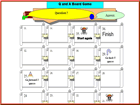
ESL Q and A Pirate Board Game - Editable Template Download here!
This game is called PIRATE because there are ugly pirate islands a student needs to cross to get to finish. Lucky ones will miss the pirate death lands. If a student lands on the pirate skull and crossbones square, they go back to start. This game can be used to add fun and get students communicating. There is a template which teachers can customize to create their own vocabulary and grammar communicative games.
Printable ESL Card Games
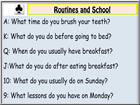
ESL Q and A Winning Cards Game - Editable Templates Download here!
This game is a genius communicative idea. Bring a pack or more of playing cards to class. Each game must have 4 sheets that represent the four types of cards - CLUB, DIAMOND, HEART, SPADE. There are questions on each sheet that match the different cards on your playing cards pack. Paste the four sheets with questions on the four walls of the classroom (mind the short students- paste it at a legible height). Students line up and you quickly give them a playing card each. They quickly match the card to a question on one of the four sheets. For example if they have a card which is 8 SPADE, they go to the SPADE questions sheet, look for question 8, go and ask someone in the class and return to the teacher to report the answer of the student they asked and get another card. The winner is the student who got the most amount of cards from the teacher.
-
Beginner Revision Game: Club Sheet
 Diamond Sheet
Diamond Sheet  Heart Sheet
Heart Sheet  Spade Sheet
Spade Sheet 
-
-
Pre-intermediate Game: Club Sheet
 Diamond Sheet
Diamond Sheet  Heart Sheet
Heart Sheet  Spade Sheet
Spade Sheet 
-
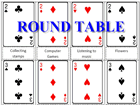
ESL Round Table Card Game- Editable Template Download here!
This Round Table card game can be used to give extended fun vocabulary, grammar and listening practice. Laminate, cut out and take the cards to class. This game is ideal for small groups of five or six. More than this is chaos. If you have a large class, split them up into small teams, but that means you have to create more sets of cards. Deal out one card each to students who sit around a table. The reason they sit round the table is to try to avoid others looking at the others' cards. The students do STONE, PAPER, SCISSORS to begin. The winner starts. The winner looks at the word on the card and gives a clue to the word. The first student to guess and shout out the word gets the card from the first player. If two or 3 students guess simultaneously, the students do STONE, PAPER, SCISSORS. The winner keeps the card.If the card is questions card, the student simply reads out the question and the first to answer gets the card.The next player in line carries on by giving clues to their card for others to guess and the game goes on. When one round has been completed, identify the winner. The winner is the one who won the most valuable card. Paste the game rules somewhere for students to see. After one round, deal out one card each for the next round. At the end of the game, the winner is the one with the most valuable card. If you still have a hard time understanding the above literature, simply understand this game as a card game variety of hot seat.
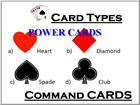
Power Cards - ESL Sentence Building Card Game - Download here Rules Sheet here!
This game gets your students communicating almost immediately. Power card game is quite easy to set up. Just print out the rules sheet, bring a pack of playing cards to class. Start by explaining the rules to students. Do a topic or grammar point you want to practice. For example if you are practicing past simple tenses, tell students each time they need to make sentences in the past simple to play each round. The verbs they use should be different each time- no repetitions. The Power or Command Cards are the cards that can be used to slow down other players. Deal out 4 cards each. Again a small group of maximum 5 and a minimum of 2 is ideal for the game. The idea is to lose all the four cards quickly by playing them on the board. If they student has command cards, they can use them to stop, slow down and interrupt the next player. By slowing down the next player, they can finish first and win. The JOKER is the worst killer card. dropping a JOKER makes the next player to go to the card bank and draw 4 cards - a SLOW DOWN strategy. The card 7 is the next slow down command card. It orders the next player to draw 2 cards from the bank. The card A stops the next player from playing a round. The card J is another power card that orders the next player to play a card type of your choice. It is a game changer. If I have a heart and which I want to get rid of, I can order the next player to play a HEART card type. When they play that I can then get rid of my HEART card type. SEE SAMPLES BELOW.
Game Templates - Make PPT Games, Printable Games using these free templates- Click here
ESL Online Interactive Fun Games
GRAMMAR GAMES
We offer a rich variety of grammar games according to grammar topics. There are grammar games like : Snakes and Ladders grammar games, Basketall, Football, Hangman, Wheel of Fortune, TV Games and more to help practice grammar.
Present Tenses Games
- Present Progressive Action Verbs - Fling the Teacher Game
- Present Progressive Tense - Hangman Game
- Present Progressive Tense - Spelling Game
- Present Simple Vs. Present Progressive - Snakes & Ladders Game
- Present Simple vs. Present Progressive - Hangman Game
- Action Verbs Picrture - Catching Game :
- Action Verbs Sentences & Picture - Catching Game
- Daily Routines Sequencing Exercise - Sequencing Game Exercise
- Daily Routines Memory Game - Matching Game
-
Past Simple, Past Progressive Present Perfect Tense Games
- Present Vs. Past Tenses - Football Game
- Present Vs. Past Tenses - Walk the Plank Game
- Past Simple - Spelling Game
- Present perfect progressive - matching game
- Irregular Past Tense - Spelling Game
- Present Tenses Vs. Past Tenses - Classification Game
- Past Simple Betting - Betting Jeopardy TV Style Game
- Past Progressive vs. Past Simple Tense - Betting Jeopardy TV Game
- Past Simple Tense - Sequencing Reading Game/Exercise
- Present Perfect vs. Past Simple Tense - Spin the Wheel Game
- Present Perfect & Past Participle - Hangman Game
-
English Tenses Exercise - Matching Game
Passive Vs. Active Voice Games
- Active Vs. Passive Voice - Basketball Game
-
Correct passive voice - Football Game
Articles (the/a/an) - Definite/Indefinite Games
-
Definite article (the) or Indefinite article (a) - Basketball Game
Modals / Modal Verbs Games
-
modals - can, must, would, have to - Basketball Game
Prepositions & Conjunctions Games
- Adjectives and Nouns followed by prepositions - Fling the teacher game
- Verbs followed by prepositions - Basketball Game
- Prepositions game - Football Game
- Prepositions of place - in, under, on at - Audio memory game
- Prepositions of time- since, during, in - walk the plank game
-
Conjunctions, if, when, although, in case, unless - Duel Game
Conditionals Games
Gerunds (-ing) and Infinitives (to) Games
-
Gerunds and infinitives - ing or to - Duel Game
Adjectives and Adverbs Games
- Adjectives and Opposites - Duel Game
- Word Groups - Walk the plank Game
- About you - Sentence Game
- Festivals, Dates and Ordinal Numbers - Sentence Game
- Greetings Sentence Game
- Hello. Hi - Greetings Audio Matching Game
- How many - Sentence Game
Assorted Grammar Games
VOCABULARY GAMES
- Snakes and Ladders Beginner Review Game
- Wheel Game - Elementary Revision Game
- Jobs Hangman Game
- Weather Catching Game
- Animal Facts True or False Maze Game
- Jobs Circle Maze Game
- DO or MAKE Collocation Spelling Game
- Weather Wild Card Spelling Game
- Zoo Animals Swap Spelling Game
- Job description matching exercise
- Action Verbs Picture Quiz
- Food Picture Quiz
-
Course 1 Lessons
Unit intro – Alphabet & Phonics Resources.
Aim: Teach letters of the alphabet
Aim: Teach basic greetings – Hello, Hi, Goodbye.
Aim: To teach kids how to say their names.
Aim: Teach kids how to say their age and learn numbers 1 to 5.
Aim: Teach kids how to count from 1 to 10.
Unit 5 A – Colours – What colour is it?
Aim: Teach kids how to describe things through colours.
Aim: Teach colours vocabulary
Unit 5 C - Green Monster Colours Lesson
Aim: Teach colours through a colours songs
Unit 6 – Fruits – I like apples.
Aim: Teach kids names of fruits and how to express likes.
Unit 7 – Body – I have a head.
Aim: Teach kids parts of the body.
Unit 8– Actions – I can, I can’t.
Aim: Teach kids how to express ability using simple action verbs.
Course 2 Lessons
Unit 1 – Animals – Farms Animals.
Aim: Teach students how to express preference by using vocabulary related to farm animals.
Aim: Teach words and expressions used when describing family.
Aim: To teach words and expressions related to classroom items.
Unit 4 – Actions – Can and Can’t
Aim: Teach action verbs
Aim: Teach various shapes and adjectives to describe size.
Unit 6 – Demonstrative Pronouns – This/That/These/Those
Aim: Teach singular and plurals of nouns and demonstrative pronouns.
Aim: Teach numbers 10 to 100 and pronunciation differences between long and short vowels.
Aim: Teach words and expressions related to toys and to ask where things are.
Unit 9 – Days of the week and weekly activities
Aim: Teach days of the week and some things we do weekly.
Unit 10 - Weather – What’s the weather like?
Aim: Teach students how to ask about the weather and describe it.
Unit 11 - Food – What do you want to eat
Aim: Teach students about the things we eat and express want
Course 3 Lessons
Unit 1 – Pets : Why do you like dogs?
Aim: Teach names of pets and give a brief description of pets using personality adjectives.
Unit 2a – Time – What time is it?
Aim: Teach students how to tell the time and also how to talk about daily routines.
Unit 2b – Time – What time is it?
Aim: Teach students how to tell the time using quarter to/past/ Half past etc.
Unit 3 – Months & birthdays – When is your birthday?
Aim: Teach students months of the year and how to tell dates using months and ordinal numbers.
Unit 4 – Jobs – What people do.
Aim: To teach kids how to describe jobs using action verbs.
Unit 5 – Actions – What are you doing?
Aim: Students will learn how to describe actions in progress using the present progressive.
Unit 6 – Transport – How do you come to school?
Aim: Teach students different means of transport and talk about going around.
Unit 7 – Clothes – What are you wearing today?
Aim: To learn to describe what someone is wearing.
Unit 8 – Where is it? – At home
Aim: Teach kids prepositions of place, alongside rooms and things at home.
Unit 9a – Vegetables – How much are the carrots?
Aim: Teach kids vegetable vocabulary and how to go shopping for veggies.
Unit 9b – Vegetables – Extra Vegetable Vocabulary lesson - Cauliflower, broccoli etc.
Aim: Teach students extra vegetable vocabulary.
Unit 10 – Weather and clothes - Put on your sunglasses.
Aim: Teach kids how to talk about clothes relative to the weather.
Unit 11 - Zoo – What does a panda look like?
Aim: To teach students how to describe zoo animals by what they eat and look like.
ESL Lesson Plans
Bilingual Resources
- English Media Lab: carefully broken down into beginner, elementary, pre-intermediate, intermediate and advanced, this website offers highly interactive grammar and vocabulary resources
- ESL-Galaxy.com : An ESL Lesson Plan portal. One of the best on the web- All free
- ESL Kids Lab- Free Resources for Teaching kids, a large variety of free resources
- Download-esl.com : Download English teaching and studying materials here- E-books, Powerpoint & more
- Chinese For Travel : Learn to speak chinese now!


